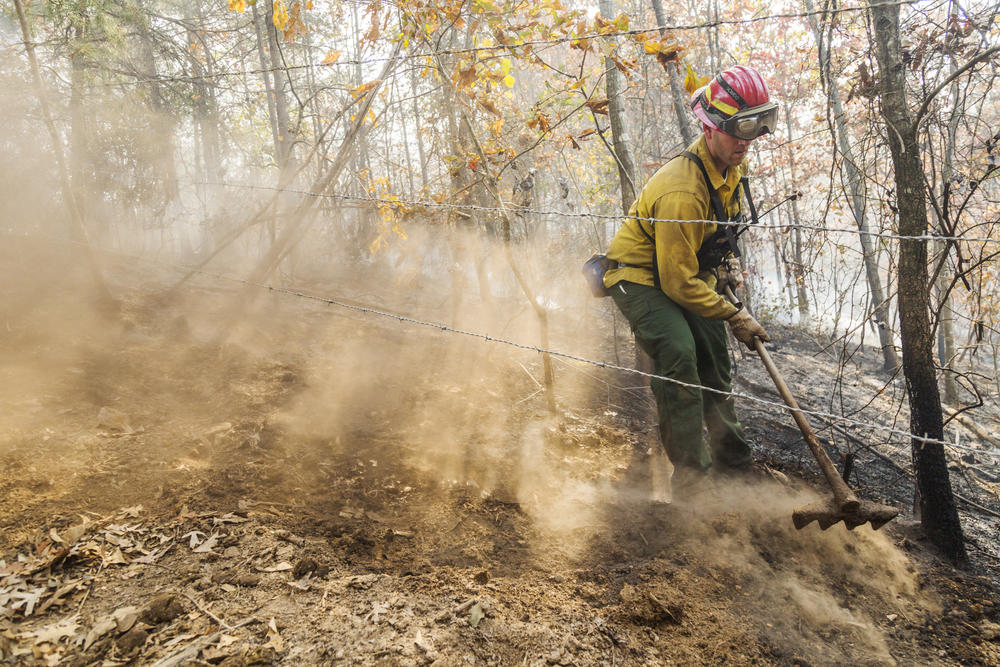Section Branding
Header Content
Fire In The Mountains: Georgia Fights Wildfires As Blazes Continue
Primary Content
Wildfires continue to burn all across the hills of north Georgia.
The U.S. Forest Service is fighting the state’s largest fires: they’re burning tens of thousands of acres in the Chattahoochee National Forest.
Georgia has to fight the fires on state and private land, and hundreds of personnel from multiple agencies are working around-the-clock to contain them.
Some of the larger fires have burned for weeks, but smaller fires pop up every day, seemingly out of nowhere. That’s what happened recently on Ryo Mountain just outside of Fairmount in Gordon County.
This time of year, the steep, forested hill behind Delores Duncan’s mobile home burns bright with autumn color. Last Wednesday, those woods actually started burning.
“It was bad last night when it was flaming up real high,” Duncan said from her back porch the following morning. “First, it was coming down the mountain over there--you could see it coming down the mountain--so we went down to see how bad it was. I guess it was about 50 feet from the bottom when we went down, and that was before dark.”
As night fell, the fire moved up the hill, threatening Duncan’s home. That’s when rangers from the Georgia Forestry Commission arrived on the scene.
They worked through the night and stopped the flames about 100 feet from Duncan’s back door. The next day, their work continued.
Once a fire is contained within fire breaks bulldozers have plowed through the trees, rangers have to make sure it’s actually out: work known as “mopping up.”
On the hill behind Duncan’s home, one ranger pointed a hose at smoldering spots in the ground. The water raised hissing sounds from the earth.
Another ranger, Eric Evans, used a rake to dig through the ash and embers, kicking up plumes of dust as he worked.
“The duff layer out here--the actual leaves and the pine straw--are so thick that it’s not just burning on the surface. It’s actually burning underneath,” Evans explained. “So, we’re having to remove some of that fuel to get to the real heat, which is under the ground. We use different hand tools, try to put some water on it, and just at least cool it off so it won’t restart.”
Evans and his partner are from west Georgia. They were headed to a larger fire, but got reassigned at the last minute. This is Evans’ second deployment to north Georgia this year.
“You know, we’ve got a lot of folks up here that’s going to miss Thanksgiving at home, but it’s part of the life,” said Byron Haire, who works for the Georgia Forestry Commission.
Haire said, lately, each new day brings new fires. On some days, as many as 50 new fires have started.
“Some of them are small. It doesn’t take a lot to extinguish [them]. Those like this one though do take several days, if it stays where it’s at,” Haire explained.
Last week, Governor Nathan Deal ordered drought designations for more than 100 counties. According to the U.S. Drought Monitor, the worst conditions are in the northwest corner of the state.
The drought has dried out forests as falling leaves continue to cover the ground in fresh fuel. Haire said those factors, along with low humidity, fall winds, and remote mountainous terrain, make fighting wildfires harder than usual.
So, the forestry commission has called in reinforcements from all over the state: local firefighters, scientists from the Department of Natural Resources, and even inmates from the Department of Corrections.
Currently, the largest state-managed fire has burned about 3,000 acres in Tatum Gulf.
The effort to fight that fire has taken to the skies. One by one, helicopters carrying 300 gallon buckets of water appear from the top of Lookout Mountain, make broad arcs through the air, and dump their payloads onto the forest canopy.
A thin brown haze obscures the sky. Plumes of smoke punctuate a palette of dying leaves. The sharp smell of burning timber fills the air, like someone set a Christmas tree ablaze.
On a high cliff above, a team works to control an intentional fire set to protect a residential neighborhood.
“We are trying to clean up some of the little hot spots that are around these peoples’ homes,” said Trina Morris with the Department of Natural Resources. “They did a burnout operation to protect the homes, and we’re trying to make sure we go back and put out anything that’s still smoldering.”
Morris is a biologist. Normally, she studies white-nose syndrome in bats. These just aren’t normal times.
“I’ve been in Georgia eleven and a half years, and I’ve never seen anything close to this,” Morris said. “We just haven’t had any rain in this part of the state, and that leads to really really dry conditions. It’s the perfect storm for fire.”
That perfect storm is expected to continue for a while longer: forecasters predict a warm, dry winter across much of the state.



